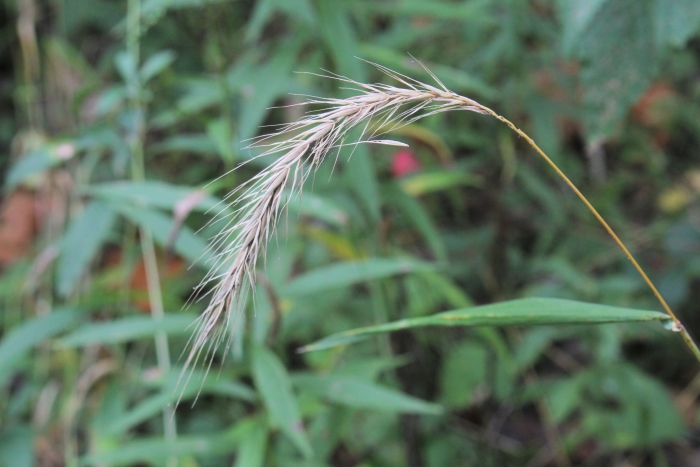Riverbank Wild Rye
(Elymus riparius)
Riverbank Wild Rye (Elymus riparius)
/
/

Quinten Wiegersma
CC BY 4.0
Image By:
Quinten Wiegersma
Recorded By:
Copyright:
CC BY 4.0
Copyright Notice:
Photo by: Quinten Wiegersma | License Type: CC BY 4.0 | License URL: http://creativecommons.org/licenses/by/4.0/ | Rights Holder: Quinten Wiegersma | Publisher: iNaturalist | Date Created: 2020-09-29T14:56:29-07:00 |

























Estimated Native Range
Summary
Elymus riparius, commonly known as Riverbank Wild Rye, is a perennial grass that is indigenous to the riparian zones, floodplains, and moist woodlands of Eastern North America. It typically grows up to 5 feet in height and features a clumping form with arching, bluish-green leaves. The plant produces elongated, wheat-like flower spikes that are greenish or purplish, which appear in mid to late summer and are moderately showy. Riverbank Wild Rye is particularly noted for its ability to stabilize soil and prevent erosion along waterways.
Riverbank Wild Rye is valued for its ecological benefits, especially in riparian restoration projects where it helps to stabilize stream banks and reduce erosion. It is also used in naturalized plantings and as a component in native grass mixes for its adaptability to moist conditions. This grass prefers full sun to part shade and grows best in moist, well-drained soils. While it is tolerant of occasional flooding, it does not thrive in prolonged dry conditions. Riverbank Wild Rye is generally low-maintenance and is not known to have significant disease or pest issues. However, it can spread by rhizomes and self-seeding, which should be considered when planting in smaller areas or where containment is desired.CC BY-SA 4.0
Riverbank Wild Rye is valued for its ecological benefits, especially in riparian restoration projects where it helps to stabilize stream banks and reduce erosion. It is also used in naturalized plantings and as a component in native grass mixes for its adaptability to moist conditions. This grass prefers full sun to part shade and grows best in moist, well-drained soils. While it is tolerant of occasional flooding, it does not thrive in prolonged dry conditions. Riverbank Wild Rye is generally low-maintenance and is not known to have significant disease or pest issues. However, it can spread by rhizomes and self-seeding, which should be considered when planting in smaller areas or where containment is desired.CC BY-SA 4.0
Plant Description
- Plant Type: Grass
- Height: 2-3.9 feet
- Width: 2-3 feet
- Growth Rate: Moderate
- Flower Color: N/A
- Flowering Season: Summer
- Leaf Retention: Deciduous
Growth Requirements
- Sun: Part Shade, Full Shade
- Water: High
- Drainage: Fast, Medium, Slow
Common Uses
Bank Stabilization, Bird Garden, Erosion Control, Low Maintenance
Natural Habitat
riparian zones, floodplains, and moist woodlands of Eastern North America
Other Names
Common Names: Eastern Riverbank Wild Rye , River Wild-Rye , Streambank Wildrye
Scientific Names: Elymus riparius , Elymus canadensis var. riparius
GBIF Accepted Name: